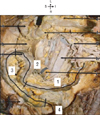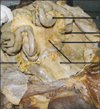1. Berardi RS. Anomalies of midgut rotation in the adult. Surg Gynecol Obstet. 1980; 151:113–124.
2. Komiyama M, Shimada Y. A case of a right-sided sigmoid colon. Kaibogaku Zasshi. 1991; 66:537–540.
3. Madiba TE, Haffajee MR. Sigmoid colon morphology in the population groups of Durban, South Africa, with special reference to sigmoid volvulus. Clin Anat. 2011; 24:441–453.
4. Madiba TE, Haffajee MR. Anatomical variations in the level of origin of the sigmoid colon from the descending colon and the attachment of the sigmoid mesocolon. Clin Anat. 2010; 23:179–185.
5. Fiorella DJ, Donnelly LF. Frequency of right lower quadrant position of the sigmoid colon in infants and young children. Radiology. 2001; 219:91–94.
6. Saxena AK, Sodhi KS, Tirumani S, Mumtaz HA, Narasimha Rao KL, Khandelwal N. Position of a sigmoid colon in right iliac fossa in children: a retrospective study. J Indian Assoc Pediatr Surg. 2011; 16:93–96.
7. Hadar H, Gadoth N. Positional relations of colon and kidney determined by perirenal fat. AJR Am J Roentgenol. 1984; 143:773–776.
8. Faure JP, Richer JP, Chansigaud JP, Scepi M, Irani J, Ferrie JC, Kamina P. A prospective radiological anatomical study of the variations of the position of the colon in the left pararenal space. Surg Radiol Anat. 2001; 23:335–339.
9. Balthazar EJ. Congenital positional anomalies of the colon: radiographic diagnosis and clinical implications. I. Abnormalities of rotation. Gastrointest Radiol. 1977; 2:41–47.
10. Siqueira SL, Lázaro-da-Silva . Arterial anatomy of the sigmoid colon useful for colon take down techniques. Arq Gastroenterol. 2003; 40:209–215.
 ).
). ).
).



